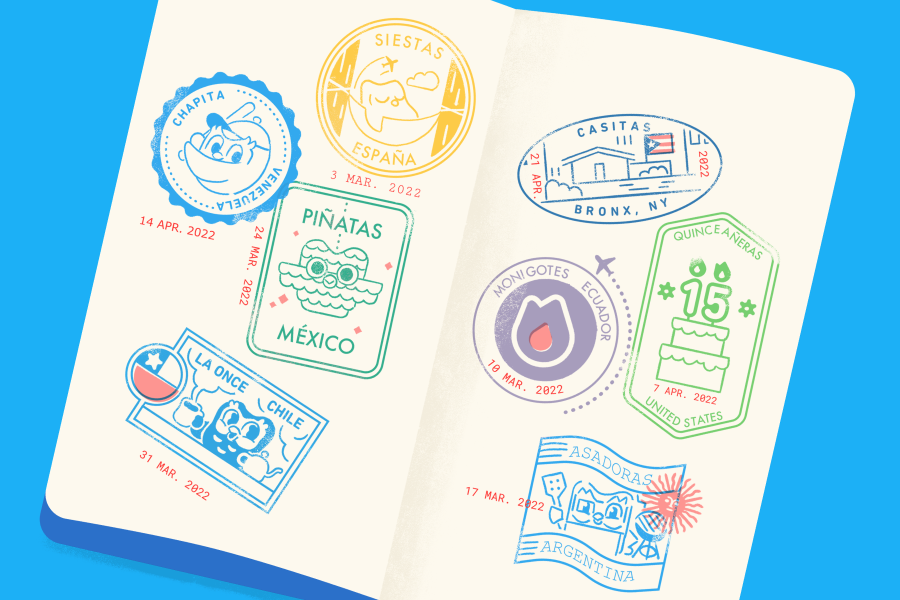Spanish is a global language used and spoken by hundreds of millions of people all around the world, and it is the second most popular language studied on Duolingo (behind English)! It has official status in over 20 countries and is represented in literature, movies, and music, from Don Quixote to Daddy Yankee to Encanto. Spanish has also recently reached the true pinnacle of pop culture influence: the latest installment of Pokémon games, Scarlet and Violet, are set in a region inspired by Spain and you'll find lots of Spanish expressions and even foods throughout!
How did Spanish become the language we know today? Its history is marked by conquest, blended culture, reconquest, standardization, more conquest, and global growth. Ready to learn more? ¡Vamos!
Latin arrives in a new land
Spanish is a Romance language, like French and Italian, but the story of Spanish starts well before the Romans arrived in modern-day Spain. From about 1100 BCE to the third century BCE, there were Celts, Iberians (who gave the Iberian Peninsula its name!), Tartessians, Aquitanians (who might have been speaking an early form of Basque), and people speaking colonial languages like Phoenician and Greek.
When the Romans arrived in 206 BCE, they brought their Latin language to the land they called Hispania. It's from that name that we get the modern words for Spain (España) and Spanish (español). The majority of words in Modern Spanish come from Latin, and many of those words still reflect not just the language of the Romans but their cultural values as well. One example—maybe surprisingly!—is related to salt. Salt was such a valued product in the Roman world that there are many words based on salt in Spanish (and in English, too!):
- el salario (the salary): from Latin salarius, "a soldier's monetary allowance for buying salt"
- la salsa (the sauce): from salsus, "salt"
- la ensalada (the salad): from herba salata, "salted vegetables"
- la salchicha (the sausage): from salsicus, "seasoned with salt"
Spanish survives the fall of Rome
After the fall of the Roman Empire in the 5th century CE, the Visigoths moved into the Iberian Peninsula and established a kingdom. They spoke a Germanic language (from the same family as English and German), but they had been interacting with Romans for a long time so they also spoke Latin (hooray for bilingualism!). Since they already knew Latin, they didn't force their own language on the Latin-speaking population in the region. As a result, their language had a relatively small impact on the Latin spoken in Iberia! But there are some Germanic words and names in Spanish that we still use today:
- Germanic words and concepts: including ropa (clothing), banda (band, like a band of warriors), and estaca (stake).
- Germanic names: including Álvaro, Fernando, Ramiro, and Rodrigo. The Visigoths in Hispania were aristocrats, so their names were seen as prestigious and were often adopted by the locals!
- Germanic name endings (!!): the -ez ending on many Spanish last names comes from the Visigoths! It was used to indicate paternity, so Álvarez was the child of Álvaro, Fernández was the kid of Fernando, etc.
Another conquest: 700 years of Arabic influence
In 711 CE, a coalition of Arabic-speaking Muslims from North Africa conquered the Visigoths and took control of the majority of Hispania. The Moors (as they were called by Christian Europeans) named their states in Iberia Al-Andalus, which is where the name of the Spanish region Andalucía comes from!
During their 700 years in Hispania, the Moors lived and worked closely with the local Romance language-speaking Christians. There are roughly 4000 words of Arabic origin in Spanish… about 8% of all Spanish words! Many of them are related to government, culture, and trade goods, like algodón (cotton), azúcar (sugar), alcalde (mayor), tarea (work, task), and rincón (corner).
And many of those Arabic words actually include two words, but they got combined into one when they were borrowed into Spanish. Here's how:
- Romance-speaking Christians heard something in Arabic starting with a- or al- (the Arabic word for "the"), as in al-qut-tun "the cotton."
- Those local Romance speakers didn't realize that the al- just meant "the" and wasn't part of the word for "cotton"—they thought the whole word meant "cotton," without "the."
- The Romance speakers started repeating the whole word and using it in their own language, saying el algodón for "the cotton"... with both the Arabic word for "the" (al) and the Romance word for "the" (el)!
Castilian Spanish is empowered by the Reconquista
Just a few years after the Moors arrived in Hispania, the Christian kingdoms in the north of the peninsula (which hadn't been conquered) began the Reconquista, a military campaign to reclaim the southern territories. During this era, Iberian Romance (what had been the dialect of Latin spoken in Hispania) really became a language distinct from Latin.
The dialect of Iberian Romance that became the standard during the Reconquista came from the kingdom of Castile, or Castilla in Spanish. It became known as castellano, which means "Castilian" or "from Castile," and even today many Spanish speakers use the word castellano as a synonym for español (Spanish).
Spanish becomes its own language
Through the Reconquista, documents continued to be transcribed in Latin. Latin itself was now also mostly for wealthy, educated elites, and everyday people were more familiar with the Castilian dialect that was evolving further and further away from Latin.
We can see the evolution of this new language in early documents written for common people (sort of the blogs of their day). For example, 10th and 11th century glosses, or hand-written notes from a monk in the margins of religious texts in Latin show the monk translating from true, formal Latin to something more like Iberian Romance, which was understood by regular people.
Here you can see a comparison of the original Latin text from the Glosas Emilianenses, the Iberian Romance gloss hand-written in the margins, its equivalent in Modern Spanish, and the English translation. (And you can even listen to a recording of how it would have sounded!) The original Latin text is pretty heavily abbreviated, but it's clear how much the Spanish has changed over time!
| Original Latin | Romance version | Modern Spanish | English translation |
|---|---|---|---|
| adjubante dño nro ihu xpo | Con o aiutorio de nuestro dueno dueno χρο, dueno ʃalbatore, | Con la ayuda de nuestro Señor Cristo, Señor Salvador, | With the help of our lord, Lord Christ, Lord Savior, |
| cui est honor et imperii cum patre | qual dueno yet ena honore et qual duenno tienet ela mandatione con o patre | Señor que está en el honor y Señor que tiene el mandato con el Padre | Lord who is in honor, Lord that has command with the Father, |
| et spu sco in scla sclor | con o ʃpu ʃco en oʃ ʃieculoʃ de lo ʃieculoʃ. | con el Espíritu Santo en los siglos de los siglos. | with the Holy Spirit for ever and ever. |
| Amen | facanoʃ dʃ ompeʃ tal serbitio fere ke denante ela sua face gaudioʃo ʃeyamuʃ. Amen. | Háganos Dios omnipotente hacer tal servicio que delante de su faz gozosos seamos. Amén. | God Omnipotent, make us do such a service that before His face joyful we are. Amen. |
1492 spreads Spanish around the world
1492 wasn't only the year that Christopher Columbus (Cristóbal Colón) reached the Americas—and brought Spanish with him—it was also the year in which Queen Isabel of Castile and King Fernando of Aragon expelled all practicing Muslims and Jews from Spain in the Spanish Inquisition. Sephardic Jews settled around the world, including in North Africa, the Mediterranean, and West Asia. Sepharad means "Spain" in Hebrew, and their language, Judeo-Spanish, spread with them. Today, the varieties of Judeo-Spanish share many similarities with 15th-century Spanish!
It was also in 1492 that the first book of Spanish grammar was published, Gramática de la lengua castellana by Antonio de Nebrija. Nebrija’s book was the first grammar of a modern European language!
Modern Spanish keeps changing and innovating
In the centuries since 1492, Spanish has become the language of more than 548 million people. After Spanish-speaking Muslims and Jews were forced out of Spain, Christian Spaniards began colonizing the Americas, and their ruthless conquest spread Spanish to a new hemisphere. As a result of contact between Spanish and indigenous American languages and gradual change over time, new Spanish dialects emerged and reflected the unique cultural and linguistic features of a community.
As Spanish grew as a world language, Spain established the Real Academia Española (Royal Spanish Academy), or RAE, in 1713 to further standardize the language. But of course, Spanish doesn't stop changing and evolving! New words continue to be borrowed into Spanish—now from a wider variety of languages—as they have been since Latin first arrived in the Iberian Peninsula.
Some of the languages that Spanish borrowed words from include French, Nahuatl (an indigenous language spoken in Mexico), Arawakan languages (indigenous to the Caribbean and South America), English, and many others. You might be surprised how many of those Nahuatl words made their way into English, too! Here are just a few examples:
- From French: flecha (arrow), cadete (cadet), fusil (rifle), banquete (banquet), parque (park)
- From Nahuatl: tomate (tomato), aguacate (avocado), chocolate (chocolate)
- From Arawakan: maíz (corn), barbacoa (barbecue), huracán (hurricane), canoa (canoe), arepa (cooked cornmeal patty, as seen in Encanto!)
- From English: béisbol (baseball), cliquear (click with a mouse), sandwich (sandwich), internet (Internet)
But incorporating new words just scratches the surface of how Spanish has evolved since arriving in the Americas! Check back soon for a new post about just how diverse Latin American Spanish dialects can be.
More recently, Spanish has been in close contact with English—especially in the U.S., where millions of bilinguals are familiar with both languages—which has led to English borrowing lots of words from Spanish! Besides the Latin American crops noted above, English has adopted other culinary concepts such as tortillas, churros, and salsa. (Remember all those salt-based words in Spanish? Salsa is one of them!)
When it comes to Spanish, todo fluye (everything flows)
Tracing its origins to Latin, Spanish has experienced constant flux, change and evolution in the eighteen centuries from the arrival of the Romans to the vast Spanish-speaking population around the world today. From a relatively remote provincial dialect, it has developed into one of the top 5 most-spoken languages in the world. And it doesn’t show any signs of stopping as it grows from El Cid to Cervantes to Isabel Allende and now, to Pokémon.



